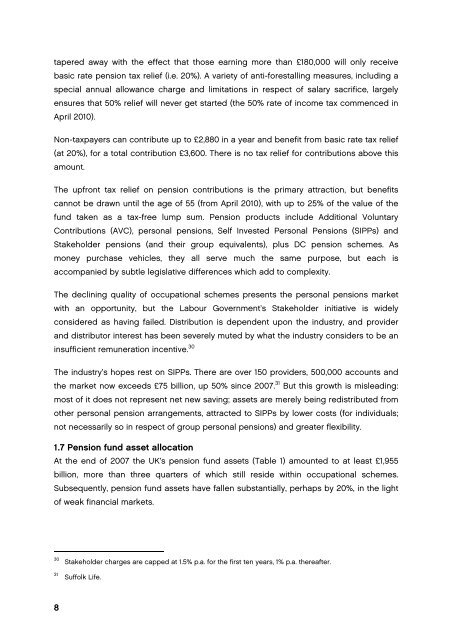Simplification is the key - Centre for Policy Studies
Simplification is the key - Centre for Policy Studies
Simplification is the key - Centre for Policy Studies
You also want an ePaper? Increase the reach of your titles
YUMPU automatically turns print PDFs into web optimized ePapers that Google loves.
tapered away with <strong>the</strong> effect that those earning more than £180,000 will only receive<br />
basic rate pension tax relief (i.e. 20%). A variety of anti-<strong>for</strong>estalling measures, including a<br />
special annual allowance charge and limitations in respect of salary sacrifice, largely<br />
ensures that 50% relief will never get started (<strong>the</strong> 50% rate of income tax commenced in<br />
April 2010).<br />
Non-taxpayers can contribute up to £2,880 in a year and benefit from basic rate tax relief<br />
(at 20%), <strong>for</strong> a total contribution £3,600. There <strong>is</strong> no tax relief <strong>for</strong> contributions above th<strong>is</strong><br />
amount.<br />
The upfront tax relief on pension contributions <strong>is</strong> <strong>the</strong> primary attraction, but benefits<br />
cannot be drawn until <strong>the</strong> age of 55 (from April 2010), with up to 25% of <strong>the</strong> value of <strong>the</strong><br />
fund taken as a tax-free lump sum. Pension products include Additional Voluntary<br />
Contributions (AVC), personal pensions, Self Invested Personal Pensions (SIPPs) and<br />
Stakeholder pensions (and <strong>the</strong>ir group equivalents), plus DC pension schemes. As<br />
money purchase vehicles, <strong>the</strong>y all serve much <strong>the</strong> same purpose, but each <strong>is</strong><br />
accompanied by subtle leg<strong>is</strong>lative differences which add to complexity.<br />
The declining quality of occupational schemes presents <strong>the</strong> personal pensions market<br />
with an opportunity, but <strong>the</strong> Labour Government’s Stakeholder initiative <strong>is</strong> widely<br />
considered as having failed. D<strong>is</strong>tribution <strong>is</strong> dependent upon <strong>the</strong> industry, and provider<br />
and d<strong>is</strong>tributor interest has been severely muted by what <strong>the</strong> industry considers to be an<br />
insufficient remuneration incentive. 30<br />
The industry’s hopes rest on SIPPs. There are over 150 providers, 500,000 accounts and<br />
<strong>the</strong> market now exceeds £75 billion, up 50% since 2007. 31 But th<strong>is</strong> growth <strong>is</strong> m<strong>is</strong>leading:<br />
most of it does not represent net new saving; assets are merely being red<strong>is</strong>tributed from<br />
o<strong>the</strong>r personal pension arrangements, attracted to SIPPs by lower costs (<strong>for</strong> individuals;<br />
not necessarily so in respect of group personal pensions) and greater flexibility.<br />
1.7 Pension fund asset allocation<br />
At <strong>the</strong> end of 2007 <strong>the</strong> UK’s pension fund assets (Table 1) amounted to at least £1,955<br />
billion, more than three quarters of which still reside within occupational schemes.<br />
Subsequently, pension fund assets have fallen substantially, perhaps by 20%, in <strong>the</strong> light<br />
of weak financial markets.<br />
30 Stakeholder charges are capped at 1.5% p.a. <strong>for</strong> <strong>the</strong> first ten years, 1% p.a. <strong>the</strong>reafter.<br />
31<br />
Suffolk Life.<br />
8

















